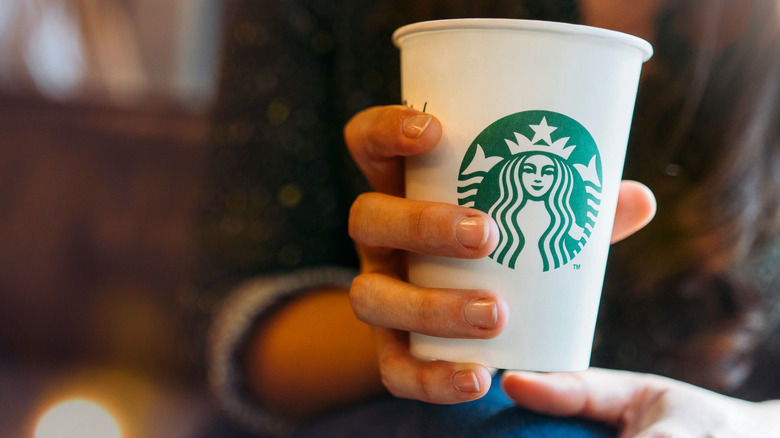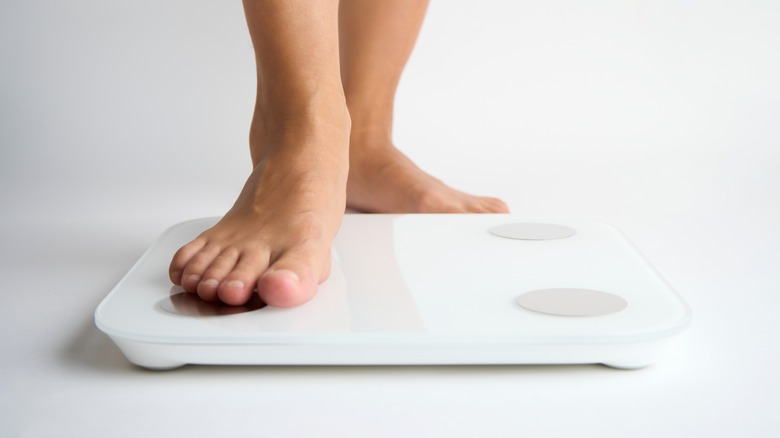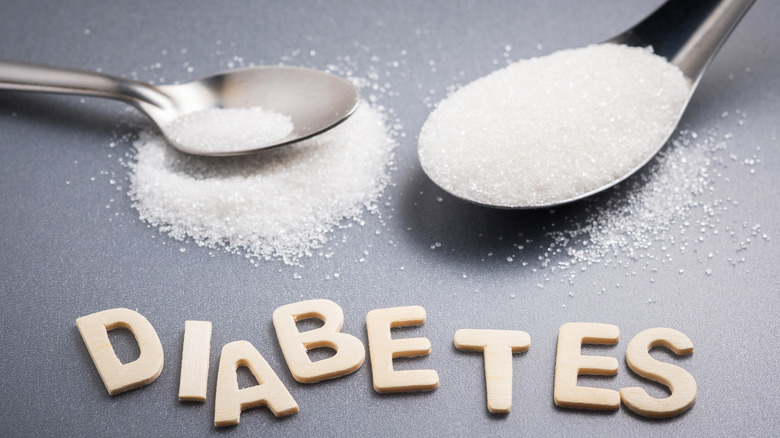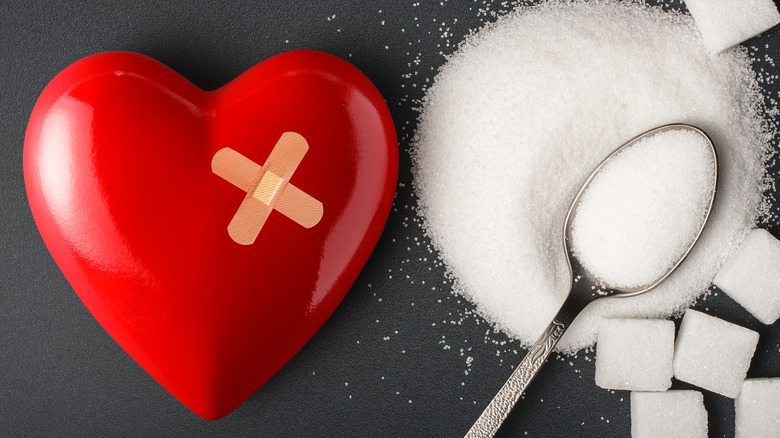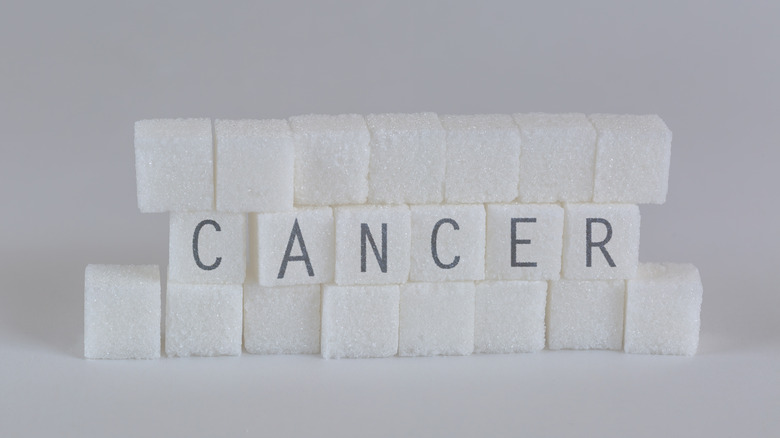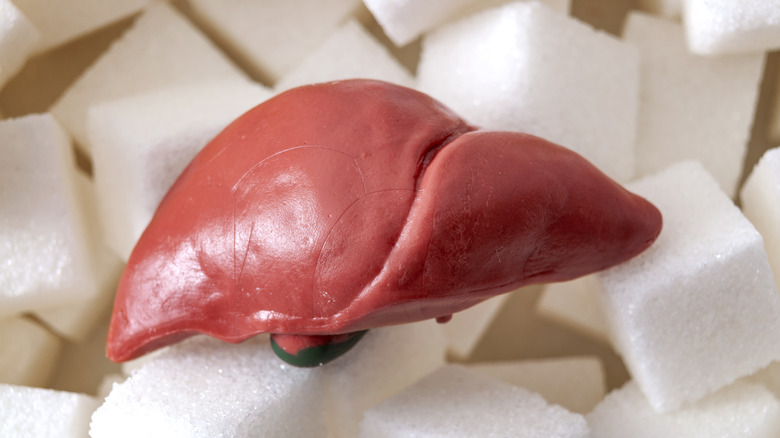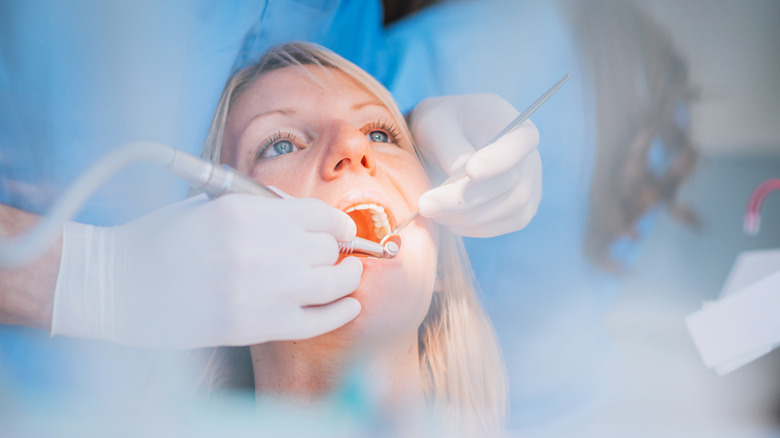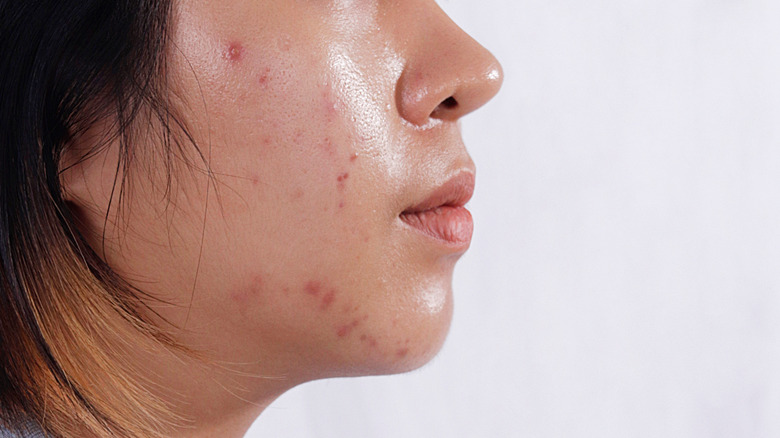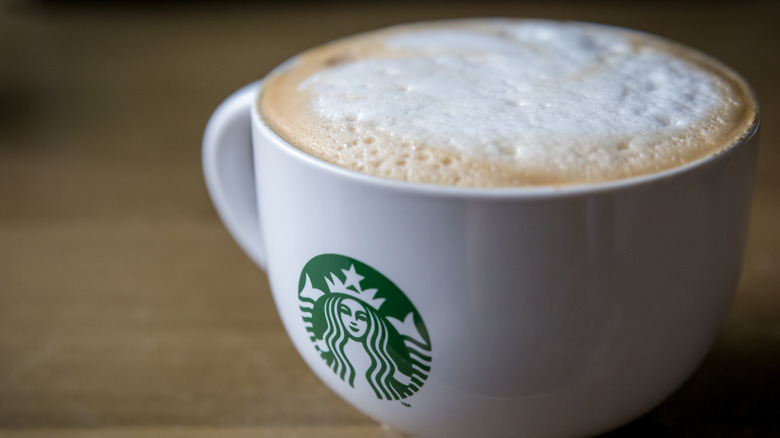What Really Happens To Your Body When You Drink A Starbucks Latte Every Day
Caffè latte may date as far back as the 1860s in Italy when coffee drinkers desired a creamier and less intense version of espresso (via Starbucks). At its core, the Starbucks latte consists of a single shot of espresso in up to 16 ounces of steamed milk, topped with foam, and served hot or iced. While many people enjoy the basic latte, others prefer to spruce up their lattes with one of several flavored sweet syrups. These include vanilla, caramel, pistachio, turmeric, and pumpkin spice. A huge autumn favorite, the Pumpkin Spice Latte is the most popular seasonal beverage in the history of Starbucks coffee, reports Today. However, this irresistible drink may be a bit much if consumed daily, considering that a 16-ounce Pumpkin Spice Latte made from whole milk has 420 calories, 18 grams of fat, and about 10 teaspoons' worth of sugar.
On the other hand, another popular Starbucks latte — the Golden Turmeric Latte — may provide extra health benefits when consumed on a regular basis (per WebMD). Curcumin — the bioactive ingredient in the spice turmeric — is well-known for potent anti-inflammatory properties. Drinking turmeric lattes may help to lower chronic inflammation linked to various diseases such as cardiovascular disease and cancer.
Are Starbucks lattes bad for your health?
When it comes to Starbucks lattes, the elephant in the room is clearly the sugar. While the roughly 8 teaspoons of sugar in a vanilla latte pale in comparison to the 18 teaspoons in a venti white chocolate mocha, it still packs quite a sugar punch (via CNN Business). More importantly, it's the liquid form that the sugar is consumed in that's especially harmful to your health, notes Healthline. Because liquid sugar doesn't trigger the release of satiety hormones that solid food does, it's easy to drink large amounts without that full feeling. Moreover, since your appetite is not satisfied, you're more apt to eat more rather than less later in the day.
You would be hard-pressed to find another food or drink more harmful to your body than a sugary beverage such as a latte. The higher the consumption of sugary drinks, the greater the likelihood that you may gain body fat or develop chronic diseases such as type 2 diabetes, heart disease, nonalcoholic fatty liver disease, and a host of other problems. Let's dig in further into how a daily Starbucks latte can affect your body and health.
Weight gain
Incredibly, two in three people in the United States are overweight or obese, according to a 2019 research review published in the Polish Journal of Food and Nutrition Sciences. Despite a reduction in fat consumption over the past three decades, obesity rates continue to soar. Although sugar consumption has also decreased since 2000, Americans still consume, on average, greater than 300% of the daily recommended amount of added sugar. Large observational studies have correlated higher consumption of sugary beverages like lattes with weight gain and obesity in both children and adults.
Apart from being a source of extra calories, sugar may contribute to weight via the gut microbiome as well, continues the review. It has been suggested that the gut microbiota in obese individuals more efficiently extracts calories from foods. Animal studies have shown that high sugar intake changes the composition and diversity of the microbiota to one that favors weight gain. Specifically, excess dietary sugar increases the ratio of Firmicutes bacteria (the "good guys") to Bacteroidetes bacteria (the "bad guys"). A high Firmicutes/Bacteroidetes ratio is characteristic of obesity in animals and humans.
Insulin resistance and diabetes
In addition to weight gain, sugar-sweetened beverages can increase diabetes risk as well. In a 2019 study published in Diabetes Care, over 190,00 participants were monitored for consumption of sugary drinks over a period of 26 years. Increasing consumption of sugar-sweetened drinks correlated with a 16-18% higher risk of type 2 diabetes. Substituting just one daily sugary drink with a sugar-free beverage (e.g., water, black coffee) lowered diabetes risk by 2-10%.
Sugary beverages are also linked to progression of insulin resistance and prediabetes, notes a 2016 study published in the Journal of Nutrition. Insulin's primary function is to lower the rise in blood sugar that occurs following a meal. In people with insulin resistance (IR), however, the body's cells do not respond well to signals from insulin. Over time, this can lead to chronically elevated blood sugar levels and the development of prediabetes, which can eventually progress to type 2 diabetes.
It is uncertain whether the sugar itself or weight gain resulting from a surplus of calories is the cause of insulin resistance. One potential mechanism for the development of IR is increased fat synthesis in the liver and fat tissue, whereby byproducts formed in the process impair the actions of insulin. Another mechanism involves the release of fatty acids and adipokines (hormones) from stores of visceral fat, which then drive IR. Visceral fat is "hidden fat" that is wrapped around internal organs and is strongly associated with insulin resistance.
Heart disease
Your heart and blood vessels may also take a hit from too many lattes and other sugary drinks. According to a 2022 review article published in the journal of Cureus, the more sugar-sweetened beverages you drink, the greater your risks of cardiovascular disease (CVD). In particular, increased risks have been observed for stroke, heart attack, and CVD-related deaths.
One way in which sugary drinks affect cardiovascular health is by causing unhealthy levels of cholesterol and fat in the blood (via the American Heart Association). People who drink more than 12 ounces of a sugary beverage on a daily basis have been shown to have nearly double the risk of low levels of protective "good" HDL cholesterol compared to those who drink less than 12 ounces per month. Also, the risk of high triglycerides was 53% higher in imbibers of sugary drinks. Studies have shown that even a mild to moderate elevation in blood levels of triglycerides is an independent risk factor for cardiovascular disease, and often occurs together with low HDL levels (via Hypertriglyceridemia).
High blood pressure
While excessive salt intake has long been implicated in high blood pressure, too much sugar may have an even stronger connection, according to a 2014 review published in Open Heart. In randomized controlled trials lasting eight weeks or more, high consumption of sugar was shown to significantly increase both systolic and diastolic blood pressure. In animal studies, sucrose (table sugar) feeding leads to high blood pressure by stimulating the sympathetic nervous system, causing the heart rate to increase and arteries to become more resistant to blood flow. Sucrose also induces insulin resistance, which causes reabsorption of sodium and thus greater sodium retention. Overall, the negative effects of sugar on blood pressure are caused by added sugars and not by sugars naturally present in foods such as whole fruits.
Beverages with added sugars (e.g., lattes), in particular, are linked to high blood pressure. A 2019 systematic review published in the Journal of the American Heart Association evaluated evidence form studies involving over 900,000 participants. Sugar-sweetened drinks were associated with a 10% increase in blood pressure.
Cancer
Sugary drinks comprise 33% of the total amount of sugar consumed by Americans, reports Today. When the consumption of sugar-sweetened beverages in close to a million Americans was tracked for 30 years, a 9% higher risk of dying from colorectal cancer and a 17% elevated risk of dying from kidney cancer was found in those who drank two sugary beverages daily when compared to participants who abstained from sugary drinks (via Cancer Epidemiology, Biomarkers and Prevention).
Evidence from a majority of studies evaluated in a 2022 review published in the journal Cancers points to an association between consumption of added sugar and cancer, particularly cancers of the breast, colon, and pancreas. Various cancer research institutions maintain that sugar's effect on cancer is driven indirectly and solely by weight gain. People who are not overweight may thus mistakenly believe that they are immune to the harmful effects of sugar. But on the contrary, animal and human studies have indicated that other mechanism may be involved. For example, strong evidence links added sugars to metabolic syndrome — a risk factor for cancer. Inflammation underlies both metabolic syndrome and sugar-induced development and progression of cancer. Furthermore, high blood sugar levels characteristic of metabolic syndrome correlate with increased risk of cancer, according to a 2014 meta-analysis published in BMC Cancer.
Fatty liver disease
Drinking those sweet lattes isn't doing your liver any favors. According to The Ohio State University, consuming one or more sugary drinks a day for five to seven years can lead to fatty liver disease. In the liver, ingested sugar can be converted to fat, which can build up over time and adversely affect liver function. Nausea, poor appetite, fatigue, and pain on your right side may be signs of a liver problem. Fatty liver disease can progress to liver scarring and eventually cirrhosis, a potentially fatal condition.
Fatty liver disease unrelated to alcohol is known as non-alcoholic fatty liver disease, or NAFLD. A significant increase in the prevalence of NAFLD in the U.S. correlates with an increase in sugar intake, per a 2018 research review published in the Journal of Hepatology. Since many people with NAFLD share risk factors in common with people with metabolic syndrome, NAFLD is considered to be the manifestation of metabolic syndrome in the liver. For example, metabolic syndrome is often associated with elevated serum uric acid. The fructose component of sugar (sucrose = 50% glucose + 50% fructose) generates uric acid and has a greater effect than pure glucose on inducing fat accumulation in the liver. Cutting back on consumption of fructose, including sugary beverages, can significantly reduce fat buildup in the liver.
Tooth decay
Among noninfectious chronic diseases occurring throughout the world, tooth decay (or dental caries) is the most prevalent, according to a 2016 review published in Advances in Nutrition. Untreated dental caries affects around 16% of children and about 24% of adults in the United States. Poor oral health can cause anxiety and pain, and negatively impact quality of life. The amount of added sugar, as well as how often it is consumed, play a major role in the development of dental caries.
Sugary beverages are a principal source of added sugars, notes the World Health Organization (WHO). Sugar from these drinks (including lattes) and foods is metabolized by bacteria present in the mouth to generate acids that wear down the enamel and dentine — the mineralized tissues of the teeth. Since the erosion of enamel and dentine worsens over time, the bulk of tooth decay occurs in adulthood. Severe dental caries often contribute to poor attendance at school or work and may result in tooth extraction.
Acne
Acne continues to be a common skin problem beyond adolescence, as noted in a 2020 study published in JAMA Dermatology. In Western countries, around half of adults older than 25 have acne, with women being affected at a higher rate. In some people, acne develops for the first time during adulthood, while in others it is a persistence of teenage acne. Adults with acne may experience psychological consequences that include social isolation, low self-esteem, and depression.
According to the American Academy of Dermatology Association (AAD), high-glycemic foods and beverages can cause new pimples by prompting a rapid spike in blood sugar — and sugary drinks such as lattes are the worst offenders. High blood sugar drives systemic inflammation, which contributes to the development of acne. Spikes in blood sugar resulting from a high-glycemic diet also stimulate overproduction of sebum, an oily substance that can clog pores and cause acne.
In a 2012 study published in BMC Dermatology, the glycemic load of participant diets was significantly higher among a group of acne sufferers than in a control group. It was suggested that high insulin levels caused by the high glycemic load triggers the production of androgen hormones (e.g., testosterone), which then increase sebum production and acne formation.
Per the AAD, acne is reduced when high-glycemic foods and drinks are swapped for low-glycemic foods (e.g., fresh vegetables and fruits, legumes, and whole grains). For example, 87% of over 2,000 people on the low-glycemic South Beach Diet for weight loss found that their acne improved, and 91% were able to reduce their acne medications.
Accelerated aging
The same chemical reaction that causes the browning or caramelization of foods when cooked also occurs in your body where it "caramelizes" your tissues, notes Life Extension. Known as glycation, this process involves the bonding of sugar molecules to proteins, fats, and nucleic acids (DNA building blocks). This results in the production of toxic compounds called advanced glycation end products, with the appropriate acronym AGEs. These destructive AGEs cause vital proteins in your body to become structurally distorted through a process called crosslinking which, in turn, leads to impaired functioning of the proteins.
For example, AGEs that build up in the skin can cause crosslinking of collagen molecules whereby strands of collagen become bonded together, resulting in collagen that is more rigid and less flexible. Over time, crosslinking of collagen in the skin can accelerate skin aging and the appearance of wrinkles. AGEs can cause damage to other cells and tissues in the body as well, affecting things like nerve and blood vessel function.
Lattes and other sugary beverages are major contributors to the formation of toxic AGEs in your body's tissues. Blood sugar levels become chronically elevated from overconsumption of high-glycemic foods and sugar-sweetened drinks. With more blood sugar circulating throughout the body, the likelihood of glycation and AGE formation increases.
Healthy alternatives
Starbucks offers several tasty sugar-free options to replace that super sweet latte, notes Healthline. First off, you could stay with the latte theme and choose the basic sugar-free version. Sugar-free hot coffee options include caffè Americano, espresso, and brewed coffee. While a double shot of espresso can pack quite a caffeine punch, the Americano is a soothing and less concentrated alternative. Among the varieties of brewed coffee roast are Blonde, Dark, and Pike Place. Apart from a sugar-free latte, lovers of milk with their coffee can select from espresso macchiato, cappuccino, flat white, and caffè misto. The first three drinks are basically espresso shots combined with steamed milk (2% or whole) and/or milk foam, whereas the caffè misto is made with brewed coffee.
If you prefer your coffee on the cold side, consider the various cold coffee options. While cold brew is always a favorite, the nitrogen-infused nitro cold brew delivers a smooth and creamy texture and flavor. Blending shots of espresso with milk and ice makes for a refreshing cup of iced flat white or iced caffè latte. If you're not a fan of espresso or milk, Iced coffee is a popular summer staple. All the above hot and cold coffee drinks can be enjoyed with flavored sugar-free syrups or sugar substitutes (e.g., stevia or Splenda).
For tea lovers, Starbucks offers a variety of sugar-free teas. Black tea options include spicy Chai tea and Earl Grey tea infused with bergamot essence and lavender. Jade Citrus Mint and Emperor's Clouds and Mist are delicious green tea varieties, while Mint Majesty and Peach Tranquility are flavorful choices for fans of herbal teas.

